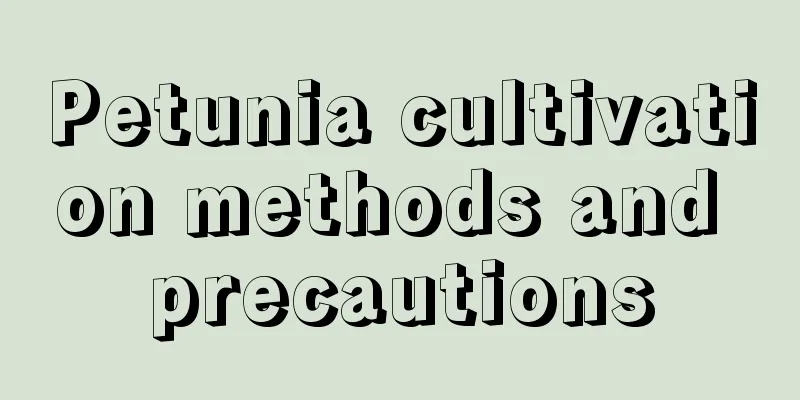Petunia cultivation methods and precautions

|
Petunia is loved by flower lovers for its short plants and luxuriant flowers. It can be easily grown to a full-size effect, and its flowers are diverse in colors and highly ornamental. However, many flower lovers will encounter some difficulties during the maintenance process. The following are the cultivation methods and precautions for petunias to help you better care for petunias. 1. Choose the right flower pot and soil The roots of petunias are shallow and will not penetrate deep into the soil, so they are suitable for short and fat flower pots. The soil should be air-permeable and well-drained, such as a mixture of leaf mold and sand, to promote the healthy growth of its capillary roots. 2. Adequate lighting Petunias require full sun to support their year-round flowering characteristics. Lack of light will cause the plant to grow weak and have difficulty flowering. 3. Reasonable watering During the growth and flowering period, petunia requires a lot of water, but avoid waterlogging. The principle of watering is "water when dry and water when wet", that is, water thoroughly after the surface of the soil in the pot is dry, and avoid frequent watering which may cause root rot. 4. Apply fertilizer at the right time In the early stages of growth, use high-nitrogen fertilizers to promote branch and leaf growth; when the plant grows to the desired size, switch to phosphorus and potassium fertilizers, such as potassium dihydrogen phosphate, to promote flower bud differentiation and flower opening. 5. Pruning and shaping Pruning can help to encourage lateral growth and increase the number of flowers. During the growing season, top the newly grown side branches, keep two leaves and then cut off the top to stimulate the growth of side buds. After the plant has formed the ideal shape, stop pruning to promote the formation of flower buds. 6. Temperature management Petunia is not resistant to low temperatures, and the most suitable growth temperature is above 10℃. In winter, the temperature must be kept above 5°C to avoid plant wilting due to low temperature. 7. Pest and disease control Pay attention to the plants, detect and deal with pests and diseases in a timely manner, and keep the plants healthy. 8. Reproduction method Petunia can be propagated by cuttings or seeds. When taking cuttings, choose healthy branches, insert them into a moist medium, provide shade and keep them moist to facilitate rooting. The above are the key points for caring for petunias. Through the above maintenance points, petunias can thrive and bloom beautiful flowers. Remember, patience and carefulness are the key to growing petunias well.
|
<<: The reasons and solutions for the yellowing of yew leaves
>>: The best way to raise fish in rice fields
Recommend
Is the banyan tree a shade or sun-loving plant?
Do banyan trees prefer shade or sun? The banyan t...
How to care for and plant newly planted Vinca rosea (Cultivation methods and precautions for Vinca rosea)
Vinca rosea soil preparation Catharanthus roseus ...
How to control the flowering period of primroses
Primroses bloom during the Spring Festival If you...
How many years does it take for Dogwood to bear fruit?
Dogwood is a deciduous tree or shrub belonging to...
How to propagate shrimp flower
Cutting propagation of Shrimp Flower The cuttings...
How often can rosemary be harvested?
Rosemary is an evergreen shrub native to the Medi...
Top 10 Flowers Ranking: The Most Popular Flowers for Home Use
Flowers refer to plants with certain ornamental v...
How to grow hydrangeas in water
1. Cut branches When growing hydrangeas in hydrop...
Does the goldfish spider plant like the sun?
Goldfish Chlorophytum likes the sun The goldfish ...
How to water cyclamen
Watering Mistakes Too much watering Cyclamen is a...
How many days does the summer peanut growing period last?
The growth process of summer peanuts can be divid...
What to do if the leaves of jasper tree are dry and burnt
1. Pay attention to cooling down Reason: During t...
Diseases and Pests of Pinus truncatula and Their Control
What are the diseases and pests of Pinus truncatu...
What is the best month to plant plum beans?
When to plant plum beans Snap beans, also known a...
When is the best time to plant Sunshine Rose?
When raising seedlings of Sunshine Rose, you can ...









